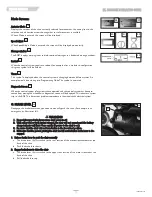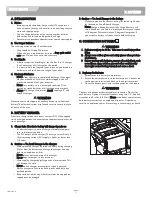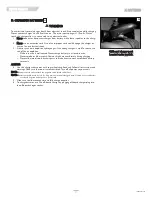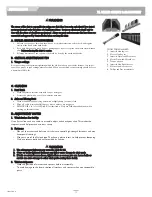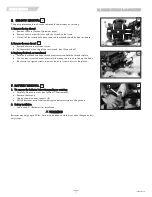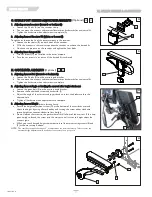
127899 Rev. A
15
Z I PP I E Z M- 3 1 0
POSITIONING BELTS
WARNING
The angle of the pelvic belt should be within the preferred zone of 45 to 75
degrees to the horizontal or within the optional zone of 30 to 45 degrees to
the horizontal. Steeper side-view pelvic belt angles are especially important if
the pelvic belt is intended to be used for postural support in addition to
occupant restraint in a frontal crash. Steeper angles will reduce the tendency
for a vertical gap to develop between the user and the belt due to compliance
of seat cushions and belt movement, thereby reducing the tendency for the
user to slip under the belt and for the belt to ride up on the soft abdomen
during normal use. Steeper belt angles also reduce the tendency for upper-
torso belts to pull the pelvic belt onto the abdomen during a frontal impact
loading.
1. Proper Installation
a. The pelvic belt should be worn low across the front of the pelvis.
b. Position the upper torso belts over the shoulders.
c. The belt(s) should not be held away from the body by the wheelchair
components or parts, including
but not limited to the armrests or wheels.
d. Ensure the belt(s) are not twisted.
e. Adjust belts as firmly as possible being mindful of user comfort
f.
Place the upper-torso belt across the middle of the shoulder and the
center of the chest, and connect to the pelvic belt near the hip of the
power chair occupant.
GENERAL USE WARNINGS
WARNING
If the total weight of the power chair exceeds 275lbs(125Kg), it is recom-
mended that two additional ANSI/RESNA WC/Vol.4, Section 18/ISO 10542
compliant rear securement straps be used to anchor the power chair during
motor vehicle transport. For power chairs that exceed the weight threshold
mentioned above, It is further recommended that the vehicle used for trans-
port have a gross vehicle weight greater than 8800lbs(4000Kg) if the option
exists.
WARNING
The buckle of the belt restraint system should not be located near any item
that may come in contact with the buckle release button in the event of a
vehicle accident or collision.
WARNING
If a recline angle is required during transport, the Power chair seat/back
should be positioned at an angle of no more than 30° to the vertical or the
occupant is at risk of injury from sliding under the restraint in the event of an
accident or collision while in the motor vehicle.
WARNING
Visually inspect all WTORS equipment at least once per month, and have
worn or broken components replaced immediately.
WARNING
Interior components that can’t be removed from the clear zones should be
padded with material that complies with FMVSS201.
6
7
8
VII. WARNINGS: COMPONENTS & OPTIONS
6
7
WARNING
Although postural supports and belts may be used in a
moving vehicle in addition to the occupant belt restraint
system, they should not be relied upon to replace occu-
pant restraints that have been designed and tested for
the purpose of securing an occupant during a motor
vehicle collision or accident. Any postural supports that
can be used during transit, must be positioned so that
they do not interfere with the clear path for proper
transit securement belt restraint.
If an Upper torso belt is in use, the anchor point(A)
should be above and behind the occupant to ensure
the occupant is properly restrained during transport.
A
8























